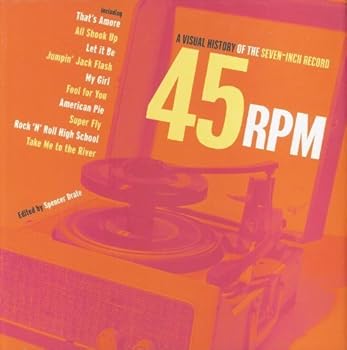45RPM. A Visual History of the Seven-Inch Record
Select Format
Select Condition 
Book Overview
Singles, 45s, 7-inchers-they have many names, but come in only one package: a square of folded cardboard with a miniature poster on either side. The gold standard of Top 40 playlists for some four... This description may be from another edition of this product.
Format:Hardcover
Language:English
ISBN:1567317936
ISBN13:9781567317930
Release Date:January 2002
Publisher:MJF Books
Length:200 Pages
Weight:1.60 lbs.
Related Subjects
Architecture Arts, Music & Photography Design Graphic Design History & Criticism Music TechniquesCustomer Reviews
4 ratings
A visual history of pop music
Published by Thriftbooks.com User , 20 years ago
45 RPM: A Visual History of the Seven-Inch Record celebrates a often overlooked, yet vital form of art, that of the seven inch sleeve. Not only are there more than 200 pictures display in this book, but an excellent history detailing the rise and fall of this format.There are basically five main chapters starting with the 50's all the way to the 90's. Each chapter is preceded by a written piece authored by different individuals, ranging from a record collector, renown sleeve artists, a music journalist and a music critic. Each provides thoughful, authorative, and interesting insights into the period of time they are introducing.The real meat is the pictures, and there are a lot of them. Some have complained that some of the pictures are of poor quality, with wear and age showing, but I felt that was part of the appeal of the book. To me, the use of sometimes worn sleeves created a natural representation of what someone's record collection might look like...I sort of felt like I was looking through a friend's record collection, or browsing through a vintage record store, rather than a book of reproduced sleeves. The artwork contained within is beautiful, thought provoking, outrageous, even shocking, but always entertaining.
A stunningly visual survey of 7-inch 45 album sleeves
Published by Thriftbooks.com User , 21 years ago
45 RPM offers a stunningly visual survey of 7-inch 45 album sleeves. The chronological arrangement features over 200 albums from all genres of music, chosen for the innovative and appealing designs. Students of design will find 45 RPM draws some important links between the art and music worlds and those with a special nostaligia for the heyday of the 45 will delight in this visually impressive compendium.
No adaptor required
Published by Thriftbooks.com User , 21 years ago
There have been quite a few "album cover" collections assembled and published, but to my knowledge this is the first volume dedicated exclusively to the art of the 7" record jacket. If you are already scoffing at the use of the term "art", be advised that this collection includes original works by Pablo Picasso (no slouch, you know), Salvadore Dali and Keith Haring! As you browse through the decades, you realize that apart from establishing the 45 sleeve as a valid form of modern art, the sequentially arranged portfolio serves as a fascinating visual montage of the development of pop music, from pre-Elvis to post-punk. Informative, engaging guest essays by artists and music sleeve designers rounds off this very worthwhile package. Music geeks will want this on thier coffee table (if there's room!)
A Fascinating and Engaging Book
Published by Thriftbooks.com User , 22 years ago
This is a engaging and attractive book. The story of how the 45 developed is what made it so interesting to me. As the introduction points out:-"The decades-long success of the 45-rpm single belies a turbulent history. In its infancy, the small disc was at the center of a fierce battle, a fight brimming with jealousy, greed and caustic recriminations. The culmination saw two rival record companies emerge victorious, with the fallout of their erstwhile battle etched deeply into the vinyl landscape of twentieth-century pop music culture."The introduction places the battle between Columbia (who had perfected the LP in 1948 and RCA (who introduced the 45 in 1949) in historical context. There was much here that was news to me. The initial 45s were issued using a colour coded system: red for classical, midnight blue for light classics, green for country-western, yellow for children's music, sky blue for international, and cerise (orange) for R & B. Traditional black wax was kept for money-spinning pop. By 1952 all RCA records were black, apart from special promotional pressings.Alongside the fascinating facts what makes the book attractive is the reproduction of covers. Chosen for their inventive design these are organised chronologically. A specialist introduces each decade in that period. There are over 200 designs - a treasure and source of ideas for anyone interested in design. For those who remember buying their first singles it also acts as a trigger to memory. It also makes it clear that single and album covers were one of the most important features of a genuine mass art.





